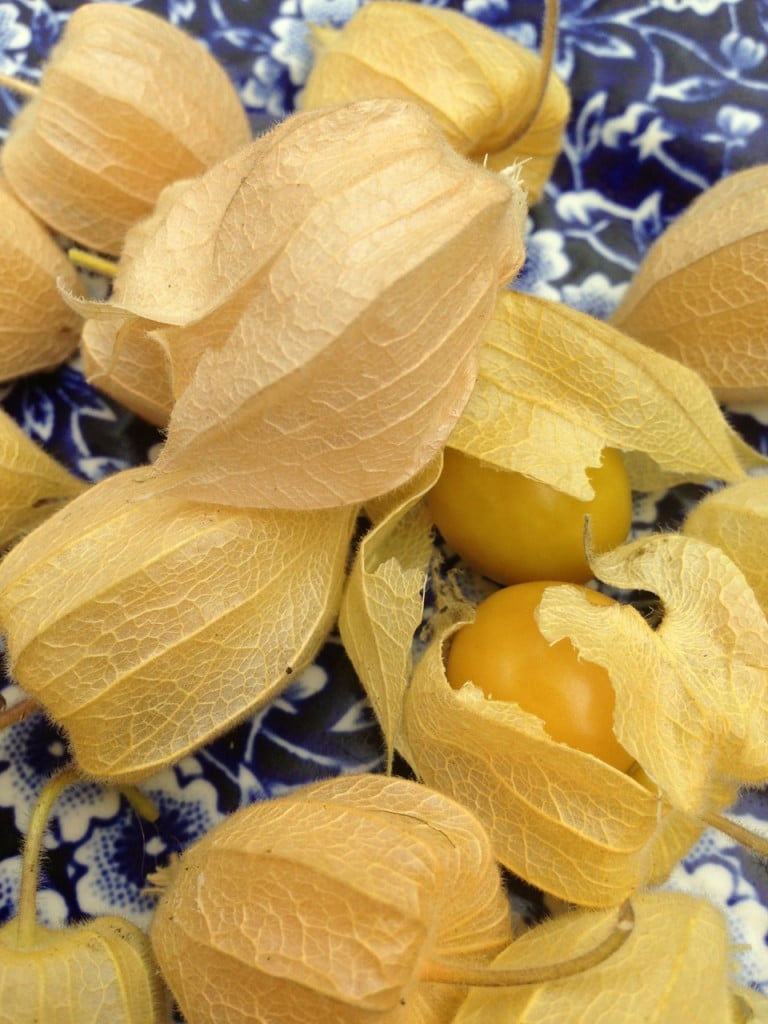There are many reasons we grow our own food. There’s nothing better than the living larder that the garden and greenhouse creates. For me it’s a reality check. While pretty much everyone relies on supermarkets for some of their shopping, being able to not only supplement the weekly shop with some really fresh and tasty ingredients is a wonderful privilege, but it wasn’t so long ago that it was a necessity. Sometimes making the most of the garden produce can be a ‘Ready Steady Cook’ experience as you marry up the flavours to create a dish that makes the most of what is sometimes just a handful of something, or a few leaves of something else.
Take this weekend; the harvest was interesting. Some crisp, but crunchy dry coriander seed, from my earlier crop of coriander leaf. Should I toast and taste it, or save it for growing more plants? What a dilemma? Then there were some intensely fragrant Spanish mint leaves, some tart but bursting with sweet and sour flavour cape gooseberries, a bowl of delicious sweet and juicy plump cherry tomatoes, wild, spicy rocket, richly hot chilli peppers, juicy strawberries and fresh basil and coriander leaves. What a mixture of flavours and all within reach of my kitchen door.
Greenhouse spice
I’ve got a love hate relationship with coriander. I used to loathe the leaves, but I now quite like them and tend to grow forests in the spring greenhouse. Like many summer stalwarts coriander has a tendency to run to seed, and as the hoverflies seemed to love the pretty lacey white flowers, I left the first few batches to run to seed. I like to sow it in succession but the timing can be rather haphazard around the flower shows, when I am usually away. The result a few weeks later is a healthy, but small crop of coriander seed. It’s a great plant as it’s a herb and a spice in one, providing juicy, tasty leaves for salads, curries and dips and plump fragrant seeds for baking and cooking.
The seed harvest needed a little attention to clean it up, but when toasted and added to the roasted carrot hummous that was on the weekend menu, well the flavours were absolutely immense. Exotic greenhouse flavours for just a little bit of time and effort. What’s more the food miles were practically negative, the seed was organic and it was all grown in peat free organic compost, no wonder the flavour was out of this world.
Minty freshness
Of course the mint doesn’t need to be in the greenhouse, but I love the smell as you brush past it on the way through the door. It’s a stock plant that I take dozens of cuttings from so that I can give them to friends and have a ready supply of leaves and shoots for mint tea. And I do over winter a few in the greenhouse for early spring shoots for tea and cakes. Mint itself is a great plant for pollinators and really popular with butterflies and bees. It can be a thug in the garden, but it’s fine of you confine it to large pots where it will still sneak a few runners out the drainage holes, but can be restricted a little.
You don’t need to bother with pricey packs of mint tea in the cupboard. With a real plant growing in the herb garden or greenhouse, you can have fresh, tasty mint tea to your heart’s content. Grow a few varieties to create a tasty brew that suits your needs. Personally I find the rich flavour of Spanish mint (Mentha spicata ‘Spanish’) a delightful fresh brew and the plant is prolific, hardy and pretty. But it is nice mixed with a softer spearmint or general garden mint to add subtle undertones of flavour.
Sugar and spice
Greenhouse fruit is always a summer treat and this year there are a few interesting things cropping in the august greenhouse. The Inca berries (Physalis peruviana) (Inca Berries Seeds)  were sown from seed courtesy of the James Wong Homegrown Revolution Range from Suttons Seeds. It’s incredibly easy to grow from seed, mine germinated last year and then overwintered in the greenhouse to flower and fruit this summer. The plants are still flowering now and producing a slow but steady crop of fat, sticky, juicy berries wrapped in pretty, lacy lantern jackets. The flavour is intense. It’s a tart pineapple-like flavour with a spicy overtone. Hard to describe, but simply delicious when ripe.
were sown from seed courtesy of the James Wong Homegrown Revolution Range from Suttons Seeds. It’s incredibly easy to grow from seed, mine germinated last year and then overwintered in the greenhouse to flower and fruit this summer. The plants are still flowering now and producing a slow but steady crop of fat, sticky, juicy berries wrapped in pretty, lacy lantern jackets. The flavour is intense. It’s a tart pineapple-like flavour with a spicy overtone. Hard to describe, but simply delicious when ripe.
I love to grow a few choice things rather than have a glut of something. That way I know I will make the most of every morsel. Inca berries are often seen in expensive restaurants adorning indulgent desserts. You can easily grow them from seed and have your own supply of berries for your own extravagant sweet creations. Grow something different from seed each year so that you can expand your knowledge and the range of ingredients for your kitchen and then savour every morsel of flavour.


